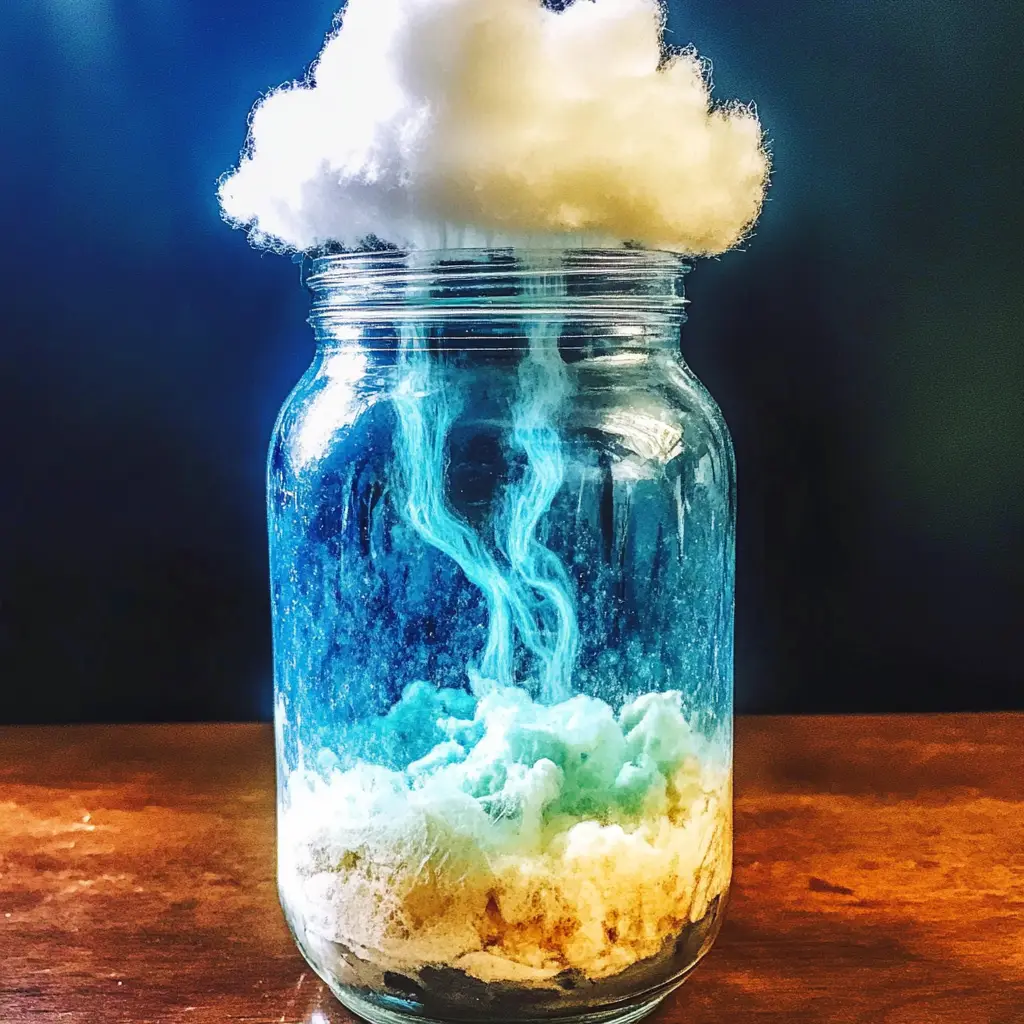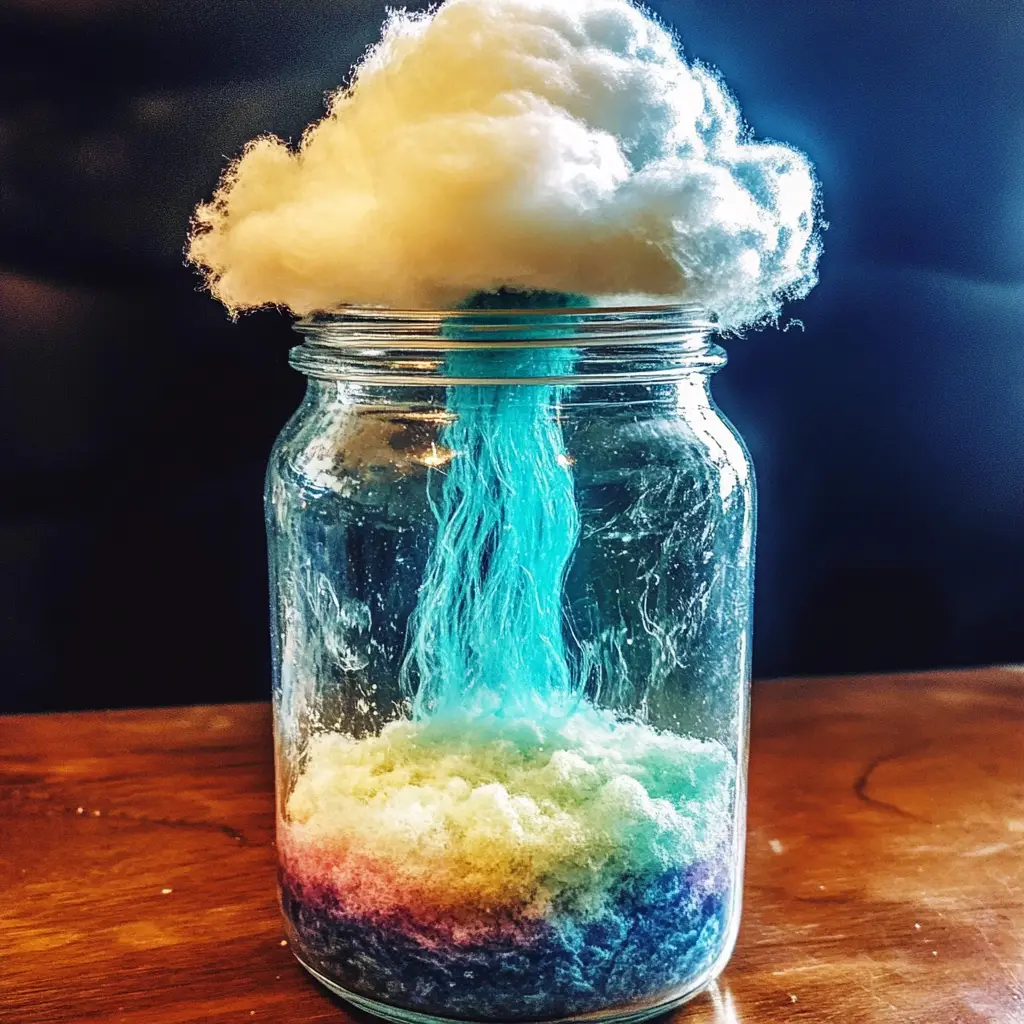Science doesn’t need to be confined to classrooms or labs—it can come alive right in your kitchen or playroom with everyday materials. One of the most enchanting ways to explore the science behind weather is the Rain Cloud in a Jar experiment. This captivating, hands-on project not only dazzles kids with colorful visuals but also teaches essential scientific concepts like the water cycle, precipitation, and cloud saturation.
With just water, shaving cream, and food coloring, you and your child can recreate the mesmerizing journey of raindrops falling from the clouds. Designed for curious minds, this simple setup transforms learning into an exciting visual adventure, helping children observe and understand how nature works—all in a safe, easy-to-clean environment.
Perfect for preschoolers, kindergarteners, and even early elementary school students, this science experiment turns an ordinary day into an extraordinary learning opportunity. It encourages observation, prediction, and critical thinking while offering plenty of room for creativity and exploration.
Why Is the Rain Cloud in a Jar Experiment So Popular?1. It’s Visually Mesmerizing
Kids (and adults!) are instantly captivated by the sight of colorful “rain” slowly dripping through fluffy clouds and swirling into water below. The contrast between the white shaving cream and the vibrant food coloring creates a magical, almost hypnotic effect that holds attention and sparks curiosity.
2. Simple, Accessible Materials
You don’t need to buy anything fancy. Most homes already have everything needed—water, food coloring, shaving cream, and a clear container. This makes it budget-friendly and convenient, especially for spontaneous educational moments.
3. Easy to Set Up and Clean
Unlike some messy or time-intensive science activities, this one is quick to set up and just as easy to clean. Within minutes, kids are watching their colorful storm unfold, and cleanup takes less than five.
4. Perfect for a Wide Age Range
Whether you’re entertaining a curious toddler or teaching elementary science concepts, this activity adapts beautifully to all age levels. Younger children enjoy the sensory and visual experience, while older kids dig into the science of weather systems and the water cycle.
5. Teaches Real Science in a Fun Way
This experiment doesn’t just look cool—it accurately models precipitation. Kids get to see how clouds form and rain falls, helping them understand abstract weather concepts in a concrete, visual format.
6. Fuels Curiosity and Critical Thinking
It invites kids to ask questions like:
-
Why is the cloud floating?
-
What happens if I add more color?
-
Why does it rain?
These open the door to deeper learning and encourage the scientific method—observation, hypothesis, and testing.
7. Highly Shareable and Instagrammable
Let’s be honest—this experiment is made for social media! Its vibrant visuals are perfect for photos and videos, which has helped it go viral in classrooms and parenting circles on platforms like Pinterest, Instagram, and TikTok.
8. Encourages Creativity and Exploration
Kids can choose their own colors, add glitter or sequins, or even invent stories to go with their “weather in a jar.” It’s not just science—it’s also an art and storytelling activity.
9. Great for Thematic Learning
It ties in perfectly with units on:
-
Weather
-
Seasons
-
The water cycle
-
Earth science
Plus, it transitions smoothly into other activities like making rain gauges or drawing weather patterns.
10. Positive Emotional Impact
This experiment creates a sense of wonder—a key driver in learning. Watching colored rain fall through clouds brings joy, excitement, and awe, making children eager to explore more.
In Summary
The Rain Cloud in a Jar is popular because it’s beautiful, simple, educational, and deeply engaging. It combines visual magic with real science, making it the perfect balance of play and learning. Whether you’re homeschooling, teaching in a classroom, or just looking for a rainy-day activity, this experiment delivers every time.

Why You’ll Love This Science Experiment
There’s a reason this activity is a favorite among parents, teachers, and homeschoolers. Here’s what makes it so special:
1. Visually Stunning
The way colored “rain” swirls down through the shaving cream and into the water is genuinely magical. It captures attention immediately and keeps kids engaged throughout.
2. Super Simple Setup
No fancy equipment or special chemicals required. If you have shaving cream, water, and food coloring, you’re already set!
3. Educational and Entertaining
Kids learn key weather concepts, including condensation, cloud formation, and precipitation—all while having a blast.
4. Creative Customization
Add glitter, mix different food coloring drops, or turn it into a rainbow storm—the creative possibilities are endless.
5. Sensory Experience
Between the smell and texture of the shaving cream, the motion of dripping color, and the visual explosion of rain, this experiment also doubles as a sensory activity for little learners.
Materials You’ll Need
-
1 large clear jar (mason jar or a tall drinking glass)
-
Water (tap water is fine)
-
Shaving cream (white foaming variety only—not gel)
-
Liquid food coloring (blue for classic rain; try rainbow colors for fun!)
-
Small bowls or paper cups (for mixing food coloring)
-
Droppers, pipettes, or teaspoons (to drizzle colored water)
-
A towel or tray (for catching spills)
✅ Optional add-ons: glitter, stickers for decorating jars, or plastic toy figures at the bottom of the jar to make a “rainy scene.”
Step-by-Step Instructions
Step 1: Fill Your Jar With Water
Start by filling your clear jar or cup about three-quarters full with water. This clear water represents the atmosphere. Make sure to leave some space at the top for the shaving cream “cloud.”
Step 2: Add Your Shaving Cream Cloud
Shake your can of shaving cream well, then spray a generous dollop right on top of the water. This fluffy foam simulates a cloud hovering in the sky. Kids may find it fun to shape or smooth the cloud with a spoon.
???? Science Tip: Clouds in the sky are made of tiny water droplets. The shaving cream represents those condensed droplets clustering together.
Step 3: Prepare the Colored Water
In small bowls, mix several drops of food coloring with a small amount of water—just enough to give it a strong, vibrant hue. You can mix up:
-
Blue for classic rain
-
Red and yellow for a sunset storm
-
All colors for a full-on rainbow rain!
???? Encourage kids to guess what color combinations will make when they mix—like red + blue = purple!
Step 4: Make It Rain!
Using a dropper, pipette, or small spoon, slowly drizzle the colored water onto the top of the shaving cream cloud. The cloud will begin to absorb the color until it becomes too heavy and releases it—just like a real cloud!
As the shaving cream becomes saturated, the color will begin to drip down into the clear water below, creating stunning streaks of “rain.”
Step 5: Observe and Discuss
This is where the magic happens! Watch as the vibrant rain twists and turns its way through the cloud and into the water, mimicking the natural process of rainfall. Encourage your child to describe what they see, notice changes, and ask questions.

The Science Behind It
This experiment models how precipitation occurs in nature. Here’s the breakdown:
-
Cloud Formation (Condensation): In the atmosphere, water vapor cools and condenses into droplets. These droplets gather to form clouds.
-
Saturation: As more and more droplets accumulate, the cloud becomes saturated—meaning it can no longer hold additional moisture.
-
Precipitation (Rain): When the cloud gets too heavy, gravity causes the water droplets to fall as rain.
In this experiment:
-
The shaving cream represents the cloud.
-
The colored water is like water droplets building up.
-
When the shaving cream becomes saturated, it releases the color—just like clouds releasing rain!
This is a wonderful hands-on demonstration of the water cycle in action.
Cleanup Tips
-
Dump the contents of the jar into the sink.
-
Rinse the jar with warm water. If shaving cream sticks, use dish soap and a sponge.
-
Wipe down any spills on the table or tray.
-
Let kids help clean up—it reinforces responsibility and makes cleanup part of the fun.
Who Is This For?
This activity is ideal for:
-
Preschoolers (ages 3–5): Focus on observation, colors, and sensory experience.
-
Kindergarten & Elementary Students (ages 6–10): Dive into basic science principles like the water cycle.
-
Homeschool or virtual learners: Works well as a visual science experiment.
-
Classroom science units: Easily scaled up for group participation.
Fun Variations and Add-Ons
Here are creative twists to elevate your experiment:
1. Rainbow Cloud
Use multiple colors in separate cups and drizzle them in layers. This creates a vibrant rainbow rain effect.
2. Glitter Storm
Add a tiny pinch of glitter to the colored water. When it rains, the glitter dances through the jar like shimmering snow or stardust.
3. Weather Storytime
Create a character like “Cloudy the Cloud” and narrate a short story about how he travels, gathers water, and finally rains on the land. Tie it into your experiment for an engaging storytelling experience.
4. Frozen Rain
Use ice-cold colored water and pour it over warm water in the jar. It adds a cool twist and shows how temperature affects density.
5. Math Tie-In
Have older children count how many drops it takes before the cloud begins to rain. Create a simple data chart comparing colors or amounts.
Educational Extensions
Want to turn this fun activity into a more educational experience? Here are some prompts and add-ons:
Science Concepts to Discuss:
-
What are clouds made of?
-
Why do clouds look white or gray?
-
What causes rain? How about snow or hail?
-
How does this experiment model real-life weather?
Vocabulary to Introduce:
-
Condensation
-
Saturation
-
Precipitation
-
Evaporation
-
Density
Printable Worksheet Ideas:
-
Draw what the rain cloud looked like before and after.
-
Label the parts of the experiment.
-
Write a short paragraph on what they learned.
Time Breakdown
| Task | Time |
|---|---|
| Setup & Preparation | 5 minutes |
| Activity Duration | 10–15 minutes |
| Discussion/Extension | 10 minutes |
| Cleanup | 5 minutes |
| Total Time | ~30–35 minutes |
Learning Objectives
By the end of this experiment, children will be able to:
-
Understand basic components of the water cycle.
-
Describe how clouds form and why it rains.
-
Practice prediction and observation skills.
-
Express curiosity about natural weather events.
-
Engage creatively with scientific processes.
FAQs
Can I use gel shaving cream?
No. Gel-based shaving creams don’t create the fluffy foam cloud effect necessary for the experiment. Use classic white foaming shaving cream.
Is food coloring safe for kids?
Yes, in small quantities. Food coloring can stain, though, so supervise closely and use a tray or towel for protection.
Can I reuse the same jar of water and shaving cream?
Not really. Once the shaving cream is saturated with colored water, it loses its cloud-like texture and needs to be replaced for a new round.
How do I make it more educational for older kids?
Add scientific vocabulary, turn it into a prediction and observation exercise, or connect it with lessons on climate, seasons, and weather patterns.
Bonus Activity: Make Weather-Inspired Treats!
After your science fun, continue the theme by making:
-
Cloud cupcakes with whipped topping
-
Rainbow fruit skewers
-
Blue Jello “rain puddles” with whipped cream clouds
This turns your experiment into a full thematic experience and makes learning unforgettable.
Conclusion
The Rain Cloud in a Jar experiment is a wonderful blend of science, creativity, and sensory fun. It gives children a chance to explore how rain is formed, watch science unfold visually, and ask big questions about how the world works. With minimal setup and maximum educational impact, this project is a must-try for parents, teachers, and homeschoolers looking to inspire curiosity in young learners.
So grab your jar, gather your shaving cream, and prepare for a rainy day full of wonder and learning—right at your kitchen table!


